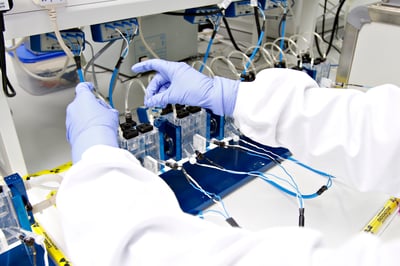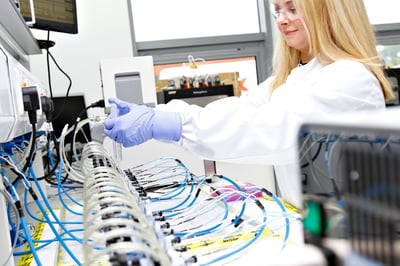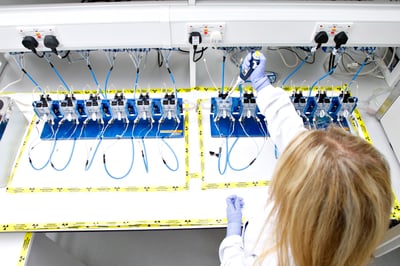Platform Technologies: Ussing Chambers
Ussing chambers are a flexible, cost-effective means of investigating mucosal drug transport or drug-mediated effects on tissue behavior. This system is used for investigations into the electrochemical properties of membranes and epithelia, most commonly the mucosae of the gastrointestinal tract or respiratory system. The setup consists of two fluid-filled, heated, gassed chambers, which are separated only by the mucosal tissue preparation. Typically, 6 to 12 isolated tissue preparations are used per donor, allowing multiple drugs to be investigated in each experiment.

Diagram showing the setup of our Ussing chamber assay
Endpoint analysis
The Ussing chamber system allows investigations in intact mucosal tissues including the electrical, metabolic, and absorptive properties of the membrane. Endpoints measured include in vitro permeability of drug compounds (Papp), phase I and II metabolism (e.g. CYP3A4 mediated metabolism of drugs), short-circuit current (Isc), potential difference (PD) measurements, and transepithelial resistance (TEER).
Ion channel function
When measuring ion channel function, it is common to record, in real-time, the potential difference (V), transepithelial resistance (Ω/cm2), and short-circuit current (mAs). Changes in ion channels (e.g. CFTR) or ion exchange mechanisms (e.g. Na-K-Cl cotransporters) result in a change in the short-circuit current. This is of major interest in mucosal biospecimins because of the role of ion channels in regulating fluid secretion.

Drug absorption, transport, and metabolism
With respect to drug absorption, transport and metabolism, Ussing chambers are recognized as the gold standard. By allowing investigations in whole tissues a phenotypically accurate balance of drug-metabolizing enzymes and drug transporters can be maintained.
To measure the passage of the drug and any metabolites, a typical experiment involves the application of a drug to the apical surface of the tissue, followed by periodic sampling of the apical and basolateral chambers. Oral bioavailability is dependent on a number of factors, two key factors being gastrointestinal permeability and metabolism.
A review by Astra Zeneca highlighted the benefits of human fresh tissue mounted in Ussing chambers for the accurate prediction of oral bioavailability. Alternative methods such as Caco-2 cells or intestinal microsomes are useful for either permeability or metabolism experiments, but not both. Moreover, using human fresh gastrointestinal tissue avoids any species differences in oral bioavailability.

Drug-mediated changes or release of mediators
This type of experimental readout once again involves the addition of test compounds to the apical and/or basolateral surfaces of the tissue. However, in this case, periodic samples collected from the bathing fluid and processing of the tissue offer a flexible method to investigate drug-mediated changes in tissue biology.
An increasingly common application of Ussing chambers is to measure the release of gastrointestinal peptides such as glucagon-like-peptide-1 (GLP-1): an incretin released from intestinal epithelial cells, in response to nutrients, that stimulates insulin release from the pancreas.
